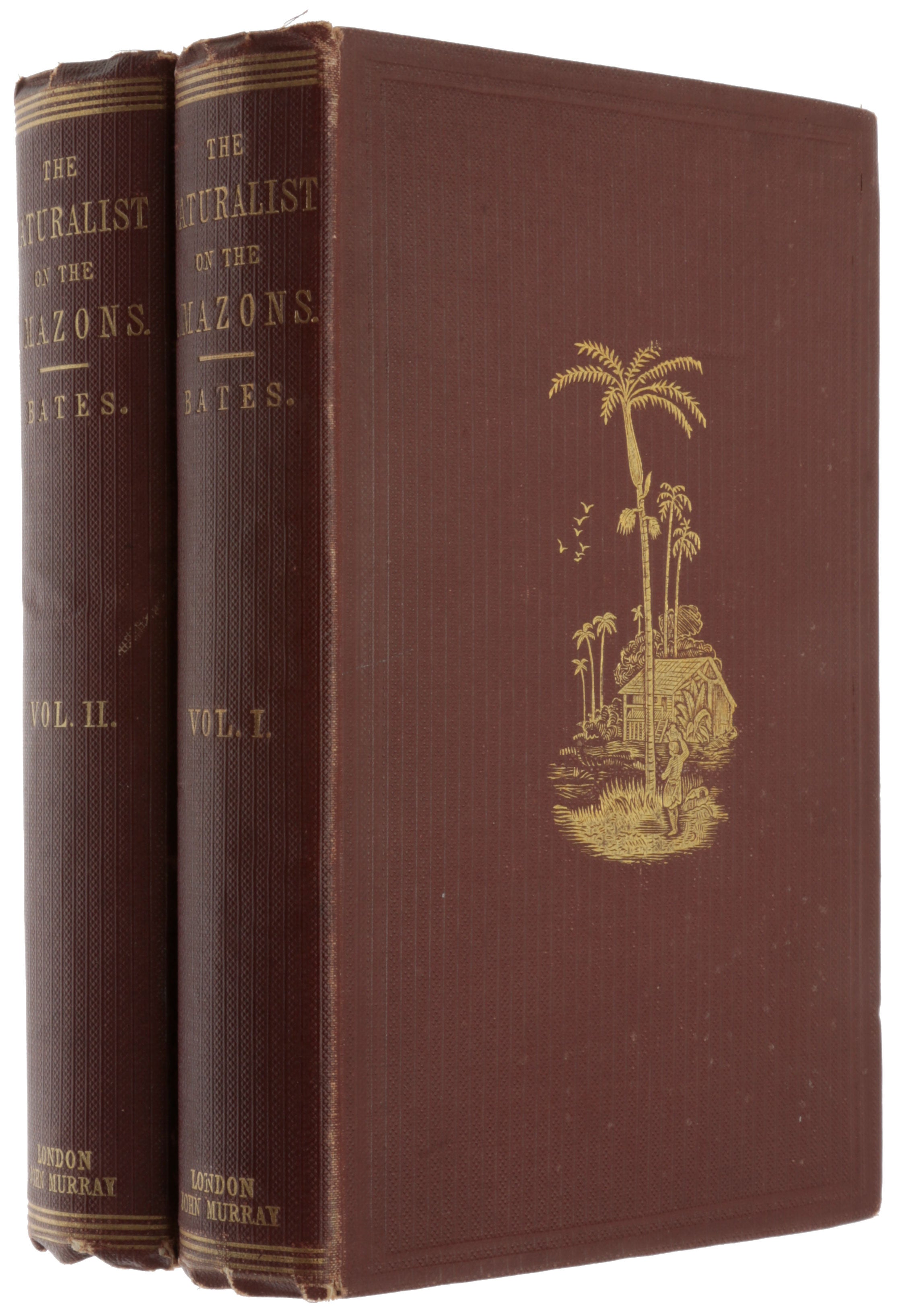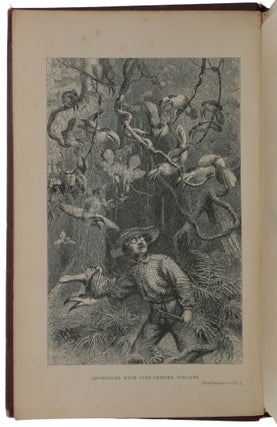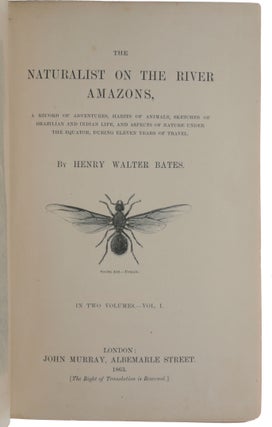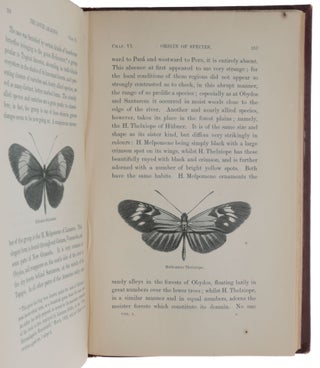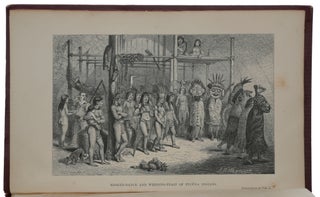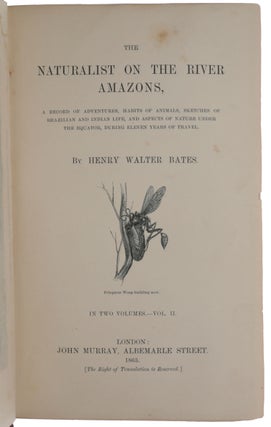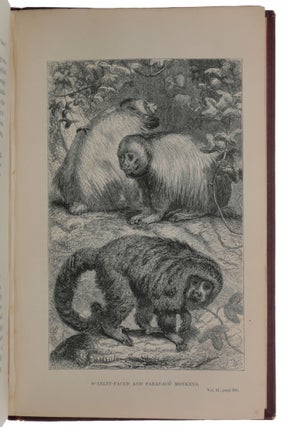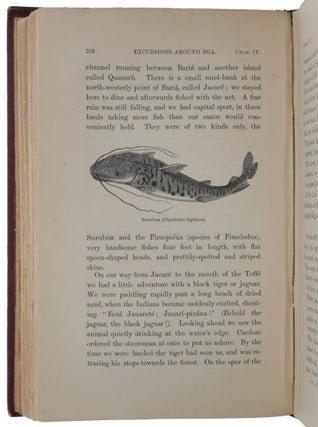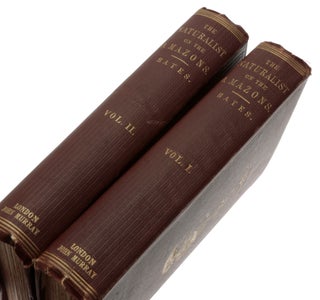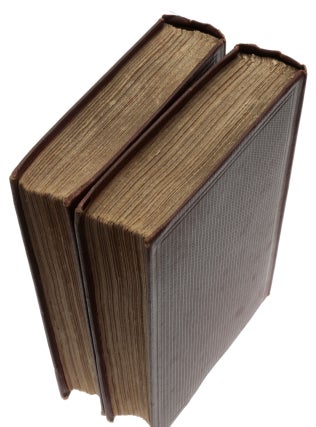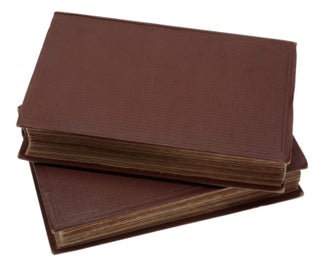The naturalist on the River Amazons, a record of adventures, habits of animals, sketches of Brazilian and Indian life and aspects of nature under the Equator during eleven years of travel.
London: John Murray, 1863. First edition of Bates’s wildly popular account of the years he spent in the Amazon region, during which he identified several thousand new species of insects and animals. He published it at the urging of Darwin, who wrote a lengthy appreciation of the book in the Natural History Review (vol. iii, 1863), and who considered it to be the best work of its kind. “During the whole of his sojourn amid the Brazilian forests his speculations were approximating to the theory of natural selection, and upon the publication of the Origin of Species he became a staunch and thoroughgoing adherent of the Darwinian hypothesis” (DNB). “In the autumn of 1847 Mr. A. R. Wallace, who has since acquired wide fame in connection with the Darwinian theory of Natural Selection, proposed to me a joint expedition to the river Amazons, for the purpose of exploring the Natural History of its banks; the plan being to make for ourselves a collection of objects, dispose of the duplicates in London to pay expenses, and gather facts, as Mr. Wallace expressed it in one of his letters, ‘towards solving the problem of the origin of species,’ a subject on which we had conversed and corresponded much together” (Bates, p. 3). Some scholars however, doubt that this quotation from Wallace is genuine. “‘Wallace himself never claimed or confirmed that this was the inspiration or aim of his first expedition. Instead he gave the aims as ‘to observe nature and make a living by collecting’” (Van Wyhe, p. 628). Nevertheless, Wallace later formulated a theory of evolution by natural selection in 1858, and Bates’s discoveries in Amazonia provided support to Darwin’s theory of natural selection. “After returning to England, [Bates] read Darwin’s Origin—and put forward his famous idea of mimicry: poorly-defended butterflies could evolve to look like brightly-coloured, protected species avoided by predators. Starting with some initial, slightly deceptive resemblance, Bates argued this would be improved by natural selection to produce the remarkable similarities observed” (linnean.org/the-society/history-of-science/henry-walter-bates). Bates (1825-92) was a self-taught English naturalist and explorer. He was born at Leicester, the eldest of four sons of a hosiery manufacturer. After leaving school he apprenticed with another hosier, and it seemed he would continue the family trade. He spent his free time in the careful observation and collection of insect life in the Leicestershire countryside and later around Burton upon Trent. In 1844 he met Wallace, then a master at Leicester collegiate school. They collected insects together and found a common interest in the writings of Darwin, and more unusually, in those of von Humboldt and Lyell. After Wallace returned to south Wales in 1846 they corresponded, and at Wallace's suggestion decided upon an expedition to the Amazon, to study the region's wildlife—collecting duplicate specimens for sale to defray their expenses—in the hope of contributing ideas to the debate about the origin of species. After rapid preparations at the British Museum and Kew Gardens, they sailed from Liverpool in the trading vessel Mischief on 26 April 1848, and arrived in Belém (then known as Pará) on 28 May. Their initial base was Belém, from where they collected locally, on the island of Marajó, and on expeditions up the River Tocantins in 1848 and 1849; they separated in 1849. Wallace returned to England in 1852, but Bates was to remain in Amazonia for eleven years, collecting around bases at Belém, Ega (1850–51 and 1855–9), and Santarém and Villa Nova (1851–5); along the Amazon; and on expeditions up the Tapajos (1852) and as far west as São Paulo on the Solimões in 1857. He worked alone, using local river craft, and, after their introduction in 1853, steamboats. Although his main interest was in insects, particularly butterflies and beetles, he also collected animals, birds, reptiles, plants, shells, and Indian artifacts. These were sold by his London agent, Samuel Stevens, to museums and private collectors, but he also sought specific items for public and private collections. In total he dispatched some 14,700 species back to England, 8000 of them new to science. During 1858 Bates’s health deteriorated and he left the upper Amazon in February 1859 and spent two months in Belém before embarking for England on 2 June 1859. He settled in Leicester, describing himself in 1863 as a worsted hosier. However, he had begun to write up the collections he had made, and produced a series of major papers, published in the Transactions of the Linnean and Entomological societies, and the Annals and Magazine of Natural History between 1859 and 1862. The most significant was the ‘Contributions to an insect fauna of the Amazon valley: Lepidoptera Heliconidae’ (Transactions of the Linnean Society, 1862) which described resemblances between two families of butterflies, of which the similarity of one to the other served as protection against predators. Such protection, or mimicry, could be an aid to survival and thus to natural selection, and has come to be known as Batesian mimicry. The phenomenon offered supporting evidence to the arguments on natural selection expounded by Darwin in the Origin. In a letter to Bates in November 1862, Darwin described the paper as one of the most ‘remarkable and admirable’ he had ever read (Stecher, p. 36), and Bates became an advocate of Darwinian ideas, making early reference to them at meetings of the Entomological and Linnean societies. In 1860 the two men had begun a correspondence which lasted until Darwin’s death in 1882. Darwin frequently asked Bates for information on the insects and other wildlife of Amazonia, and it was at his suggestion that Bates wrote an account of his travel experiences, Darwin recommending Bates to his own publisher, John Murray. The Naturalist on the River Amazons was a major contribution to the knowledge and literature of Amazonia. Bates had spent longer on the Amazon than any of his European predecessors, and the book was an immediate success and has become a travel classic with admirers which include Darwin, D.H. Lawrence, George Orwell and others. Written in clear and vivid language, Naturalist stayed popular longer than did the works of Spruce and Wallace. It remained in print through the nineteenth century, in eight editions, and was also published in Russian, German, and Swedish in 1865, 1866, and 1872, respectively. It is a curiously structured book, part detailed diary, part general account of the region, and part precise description of particular fauna, but it provides a fascinating record of the natural environment and wildlife of Amazonia before the major impact of the rubber boom. There are also detailed descriptions of the way of life and customs of Amerindian groups Bates encountered on his travels. The book’s enduring appeal lies in its elegant yet scientific pen-portraits of places, people, and wildlife, as in his description of the wings of the varied and beautiful butterflies he observed around Ega: ‘on these expanded membranes nature writes, as on a tablet, the story of the modification of species, so truly do all changes of the organisation register themselves thereon’ (Bates, p. 353). In 1864, with the support of Darwin and Murray, Bates became the assistant secretary of the Royal Geographical Society, effectively its principal full-time official. During his tenure the society gave direct support to eighteen major expeditions, including those of Livingstone and Stanley in Africa, Chandless in Brazil, Trotter in the Pamirs, and Nares to the Arctic. It was said of Bates that he knew all of the great and most of the lesser travellers of this heyday of Victorian exploration, and counted as friends Livingstone, Stanley, Edward Whymper, Darwin, Joseph Hooker, Wallace, Huxley, Murchison, Markham, Francis Galton, and MacKinder. His 27 year tenure at the Royal Geographical Society coincided with a crucial period in the development of geography in Britain, a transition from its essentially explorer tradition to its establishment as an academic discipline in schools and universities. Wallace and others claimed that Bates’s duties at the RGS were to the detriment of his activities as a naturalist, but throughout the period after his return from Brazil he sustained an impressive stream of entomological publications, initially from his own collections, and later on insects sent to him by travelers from around the world, but particularly from the tropics. Borba de Moraes I, p. 77; Sabin 3932a. Stecher, ‘The Darwin-Bates letters correspondence between two nineteenth-century travellers and naturalists, Part I,’ Annals of Science 25 (1969), pp. 1-47. Van Wyhe, ‘A delicate adjustment: Wallace and Bates on the Amazon and ‘The Problem of the Origin of Species’,’ Journal of the History of Biology 47 (2014), pp. 627–59.
Two vols., 8vo. (197 x 121 mm), pp. [ii, frontispiece], [ix], 351, with 4 engraved plates and folding map at rear, plus 32 pp. of publisher’s advertisements; [ii, frontispiece], vi, 423, with 3 engraved plates, illustrations in text (tiny tear to map edge not affecting image). Original maroon publisher's cloth with gilt stamped pictorial upper covers, gilt spines, dark red endpapers (light wear to extremities).
Item #5283
Price: $4,800.00

